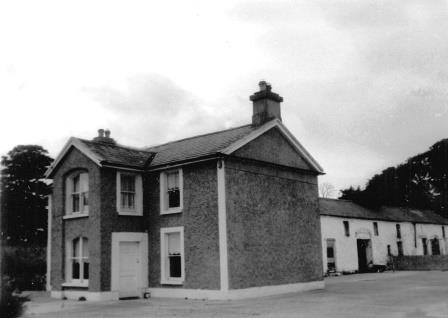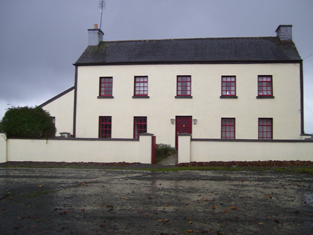Cashlieve House
Houses within 10km of this house
Displaying 23 houses.
Houses within 10km of Cashlieve House
Displaying 23 houses.
| House name | Description | |
|---|---|---|
| Clonalis House | The present Clonalis House was built in the late 1870s replacing an earlier Georgian house, the ruins of which can be seen at Clonalis. Charles Owen O'Conor, the O'Conor Don, lived here at the time of Griffith's Valuation when the existing house was valued at £35. In 1814 Clonalis is recorded as the residence of John Balfe. The Census of Elphin records Margaret O'Conor as residing in Clonalis in 1749. |

|
| The Hermitage | The original house, named Hamlet Cottage, was beside the road and is marked on the 1838 Ordnance Survey map. A new house was later built and is labelled The Hermitage on the 25-inch Ordnance Map of the 1890s. A house is still extant at the site. |

|
| Roseberry House | Described as 'an excellent two story slated house' in 1850. At the time of Griffith's Valuation it was held in fee by William Bodkin and valued at £15. This house is no longer extant. | |
| Springfield House | 18th century two-storey thatched house, described in 1863 as a house of ancient construction, still occuppied by the McDermott family in the early 20th century. At the time of Griffith's Valuation, it was occupied by Owen McDermott who was leasing from William McDermott and Glasgow Connolly and was valued at almost £12.. Portion of the house is still extant. |

|
| Loughglynn | Loughglynn was the main residence of the Dillon family, built circa 1715, extended in the 1820s and altered again in the early 20th century. It is recorded in 1814, 1837 and in Griffith's Valuation as the seat of Viscount Dillon. The Dillons were absentee landlords for much of the nineteenth century and their agents, the Stricklands, lived in the house. During the twentiethcentury the house served as a convent. Loughglinn House is still extant. |

|
| Harristown | Harristown was the residence of James Young in the 1870s and at the time of Griffith's Valuation when it was valued at £20. In 1814 it was the seat of Capt. Young. Lewis records it as the seat of Owen Young. In 1894 Slater refers to it as the seat of Owen W. O'Grady Young. The Census of Elphin records the Young family at Knockro, parish of Kilkeevin, in 1749. Much of the demesne associated with Harristown is now occupied by Castlerea Prison. | |
| Caher | Charles French was leasing the house at Caher, barony of Frenchpark, valued at £16, from Lord de Freyne's estate, at the time of Griffith's Valuation. Lewis also records the house as the residence of C. French in 1837. In the same year the Ordnance Survey Name books record Caher as a "dwelling house of three stories and slated". In the 1749 Census of Elphin F. Elwood was recorded as residing at Caher. By 1894 it was the residence of the Dowager Lady de Freyne. The building is still extant. | |
| Coolagarry | Charles Ellison was leasing a property at Coolagarry valued at £8 10s from Viscount Dillon's estate at the time of Griffith's Valuation. The Ordnance Survey Field Name books record that there were no houses that could be called farmhouses in this townland in 1837 so it is assumed that Coolagarry must have been constructed 1837-1855. There is still a house extant at this site. |

|
| Errit Lodge | Errit Lodge, valued at £12, was the residence of Fitzstephen French at the time of Griffith's Valuation. It is recorded as Lough Errit by Lewis in 1837 when the Ordnance Survey Name books describe it as " a well built house, two stories high and slated with detached offices". Slater refers to it as the seat of Hon. Charles French in 1894. In 1814 Errit is recorded as the residence of John Barlow. The Census of Elphin in 1749 also records it as a residence of W. Barlow. A modernised and derelict building now occupies the lakeshore site. |

|
| Glebe West | The Rev. Harlow Fleming was occupying the house valued at £6,at Glebe West, barony of Frenchpark, at the time of Griffith's Valuation. It was church property, being leased from the Bishop of Elphin. The house is still extant and apparently occupied. |

|
| Arm Lodge | William Lloyd was leasing a property valued at £8 to Laurence Henry at Arm, barony of Castlereagh, at the time of Griffith's Valuation. Lewis records this property as Arm Lodge, a seat of W. Lloyd in 1837. In 1814 Arm Lodge was the residence of Mr. John Cotton and in the 1870s of William Garnett. A house is still extant at the site. | |
| Dalefield | Lewis records a house called Dalefield, parish of Kilkeevin, as the seat of J. Grey in 1837. At the time of Griffith's Valuation Alice Gray was leasing a property valued at £10 to Charles O'Connell. In 1814 Dalefield was the residence of Michael O'Flinn. | |
| Caher | At the time of Griffith's Valuation, Harriett Dickson and Maria Squirl were leasing a property valued at £5 together with 235 acres at Caher, barony of Castlereagh, to Bernard Sweeney. | |
| Cloonkeen House | Patrick Sweeney was leasing a house valued at £12 at Cloonkeen, barony of Castlereagh, from the Sandford estate at the time of Griffith's Valuation. It is labelled Cloonkeen House on the 25-inch edition of the Ordnance Survey map. A house is still extant at the site. | |
| Castlereagh House | The principal residence of the Sandford estate was at Castlereagh House, barony of Castlereagh. It was valued at £80 at the time of Griffith's Valuation. In 1786 Wilson described it as "a most elegant and capital seat". In 1894 it was the residence of G.R. Wills-Sandford, Castlereagh House has been demolished. Gate lodges, one of which functions as Gaynor's Funeral Home, survive while part of the demesne lands is a public park for Castlerea town. |

|
| Longford Glebe | Longford House is best known as the birthplace, in 1860, of the first President of Ireland, Douglas Hyde. At the time of Griffith's Valuation it was leased by Rev. John Oldfield to William Cotton and was valued at £10. It is still extant and occupied as a private dwelling. |

|
| Willsbrook House | Originally a property of the Wills family who inherited the Sandford estate through Mrs. Mary Wills. In the 1850s Willsbrook was leased by Michael O'Connor. In 1814 it had been the seat of Daniel O'Connor. Willsbrook House is no longer extant. | |
| Ballinlough | Rev. Robert Blundell was leasing a property valued at £16 at Ballinlough, parish of Kiltullagh, from the Sandford estate at the time of Griffith's Valuation. This appear to be the Glebe House. It is now a ruin. | |
| Willsborough | Henry Sampy was leasing a property valued at £3 10s + 155 acres at Willsborough, barony of Castlereagh, from the Sandford estate at the time of Griffith's Valuation. In 1814 this property was the residence of Walter Jordan. The site of Willsborough House is now occupied by the Community Centre and pitches of Michael Glaveys GAA Club. A memorial stone for a dog owned by Helen Sampey is preserved against the wall of the building. |

|
| Lowberry | The Encumbered Estates' Sale notice of May 1856 indicates that the mansion at Lowberry had "formerly" stood in the demesne and recommends it as a "most desirable site for building". It is shown on the First Edition Ordnance Survey map but no buildings are recorded in the townland at the time of Griffith's Valuation. It is labelled "Lowberry House (in ruins)" on the 25-inch map of the 1890s. A portion of these ruins still remain at the site. | |
| Derry Lodge | At the time of Griffith's Valuation, Elizabeth Sandford was leasing a house at Derry, barony of Frenchpark, valued at £6 from the French estate. The house is described in the Ordnance Survey Name books of 1837 as "a good house, two stories high and thatched". The first edition of the Ordnance Survey map indicates a mill and a building described as "site of old iron works" close to the site. A modern building is located at Derry now. | |
| Marnellsgrove | The home of the Marnell family at the beginning of the 19th century. Richard Marnell was resident in 1814. | |
| Dunmore Lodge | Melvin states that the Dunmore estate had been inherited by the Gores in the early eighteenth century and that Ralph Gore resided at Dunmore during that century. His mansion was subsequently in use as a barracks until it was destroyed during the Civil War in the early twentieth century. Marked on the Taylor and Skinner map of 1778 as the residence of the Earl of Ross and also noted as "the fine seat of the Earl of Ross" by Wilson in 1786. In 1814 Leet noted "Dunmore Lodge" as the residence of John Egan. |

